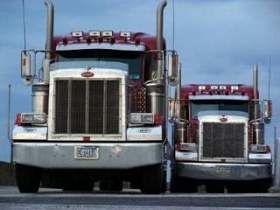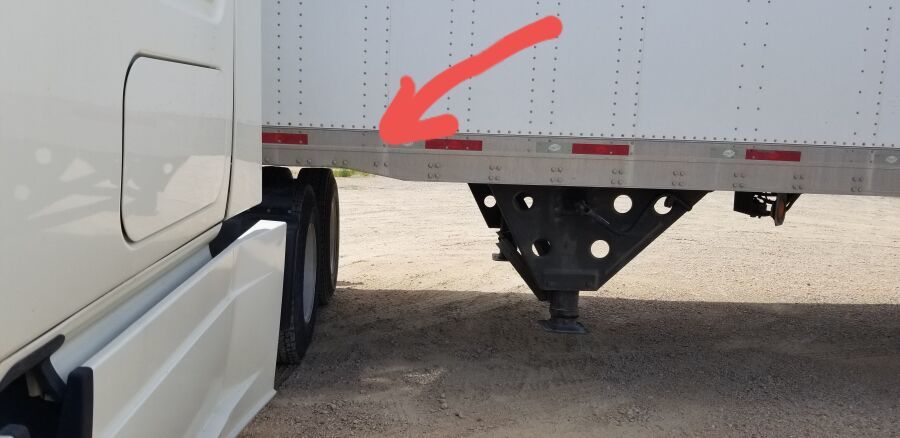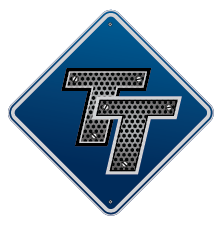Parallel Parking Maneuver Issues
Topic 30236 | Page 1
I don't know if how we did it would be of any use, we learned with a 53 trailer. Only did blind side. For set up we pulled straight about a foot off the hole, up to a black line on the pad that put our tandems pretty much even with the cone for the edge of the box, then it was L to 3/4 of second reflector covered by cowling, right til straight, go straight back til step mirror on right is even with cone. Goal, adjust forward or back based on 3' from trailer edge at rear to line of cones, then right to tip of triangle of landing gear frame shows in mirror, then straight back til rear drive covers line, then left til mirror edge and hood mirror make line with entrance cone.
Assuming that you would reverse the directions of wheel for sight side. Idk, never had to do it, also ours was a 53' trailer and the lines on our pad were specifically for that. So probably no help...I also have not found any backing in real life that remotely resembled what we did there.
Tandems:
Tandem Axles
A set of axles spaced close together, legally defined as more than 40 and less than 96 inches apart by the USDOT. Drivers tend to refer to the tandem axles on their trailer as just "tandems". You might hear a driver say, "I'm 400 pounds overweight on my tandems", referring to his trailer tandems, not his tractor tandems. Tractor tandems are generally just referred to as "drives" which is short for "drive axles".
Tandem:
Tandem Axles
A set of axles spaced close together, legally defined as more than 40 and less than 96 inches apart by the USDOT. Drivers tend to refer to the tandem axles on their trailer as just "tandems". You might hear a driver say, "I'm 400 pounds overweight on my tandems", referring to his trailer tandems, not his tractor tandems. Tractor tandems are generally just referred to as "drives" which is short for "drive axles".
This is just my personal opinion - the best thing you can do to improve your backing skills is forget what they told you at CDL school about cones, inches, and especially rivets :-) Just look where your tandems go, use every mirror you can, go slow and get out as often as you need.
CDL:
Commercial Driver's License (CDL)
A CDL is required to drive any of the following vehicles:
- Any combination of vehicles with a gross combined weight rating (GCWR) of 26,001 or more pounds, providing the gross vehicle weight rating (GVWR) of the vehicle being towed is in excess of 10,000 pounds.
- Any single vehicle with a GVWR of 26,001 or more pounds, or any such vehicle towing another not in excess of 10,000 pounds.
- Any vehicle, regardless of size, designed to transport 16 or more persons, including the driver.
- Any vehicle required by federal regulations to be placarded while transporting hazardous materials.
Tandems:
Tandem Axles
A set of axles spaced close together, legally defined as more than 40 and less than 96 inches apart by the USDOT. Drivers tend to refer to the tandem axles on their trailer as just "tandems". You might hear a driver say, "I'm 400 pounds overweight on my tandems", referring to his trailer tandems, not his tractor tandems. Tractor tandems are generally just referred to as "drives" which is short for "drive axles".
Tandem:
Tandem Axles
A set of axles spaced close together, legally defined as more than 40 and less than 96 inches apart by the USDOT. Drivers tend to refer to the tandem axles on their trailer as just "tandems". You might hear a driver say, "I'm 400 pounds overweight on my tandems", referring to his trailer tandems, not his tractor tandems. Tractor tandems are generally just referred to as "drives" which is short for "drive axles".

This is just my personal opinion - the best thing you can do to improve your backing skills is forget what they told you at CDL school about cones, inches, and especially rivets :-) Just look where your tandems go, use every mirror you can, go slow and get out as often as you need.
I actually failed this maneuver for the dmv test. I got the rig in on the first try almost perfectly straight and square in the box, but backed up a little too far and hit the rear boundary wall and the examiner made me start the maneuver over. That really discouraged me and my nerves started getting the best of me to the point where I felt I was about to have a panic attack and I ended up racking up 12 points. I think I only pulled up about 7-8 times but I think the examiner realized I was having a really bad time and just stopped me after I ran over a cone. The fact I couldn't see the rivets and also couldn't really use the landing gear for reference either since there was a panel on this particular tractor obstructing my view of the drive tires didn't help of course.
What you say about using the tandems makes sense though.
I can only GOAL twice for the test though. Of course I should save one for the final check before I blow the horn but I'm trying to decide where I should use the other GOAL. My biggest issue by far is getting that first 45 degree angle. if I could figure out a reliable method of getting that part right no matter what truck I'm in then the rest of the maneuver is easy. Second biggest issue is nerves. At school I nail this maneuver almost every single time no problem because I'm not nervous. Completely different story during the test. I got it in perfect the first try because I wasn't so nervous, but after hitting the wall and having to start over- that all changed.
Its truly amazing how anxiety can affect a persons ability to perform something they've practiced so much already.
CDL:
Commercial Driver's License (CDL)
A CDL is required to drive any of the following vehicles:
- Any combination of vehicles with a gross combined weight rating (GCWR) of 26,001 or more pounds, providing the gross vehicle weight rating (GVWR) of the vehicle being towed is in excess of 10,000 pounds.
- Any single vehicle with a GVWR of 26,001 or more pounds, or any such vehicle towing another not in excess of 10,000 pounds.
- Any vehicle, regardless of size, designed to transport 16 or more persons, including the driver.
- Any vehicle required by federal regulations to be placarded while transporting hazardous materials.
Tandems:
Tandem Axles
A set of axles spaced close together, legally defined as more than 40 and less than 96 inches apart by the USDOT. Drivers tend to refer to the tandem axles on their trailer as just "tandems". You might hear a driver say, "I'm 400 pounds overweight on my tandems", referring to his trailer tandems, not his tractor tandems. Tractor tandems are generally just referred to as "drives" which is short for "drive axles".
Tandem:
Tandem Axles
A set of axles spaced close together, legally defined as more than 40 and less than 96 inches apart by the USDOT. Drivers tend to refer to the tandem axles on their trailer as just "tandems". You might hear a driver say, "I'm 400 pounds overweight on my tandems", referring to his trailer tandems, not his tractor tandems. Tractor tandems are generally just referred to as "drives" which is short for "drive axles".
Dm:
Dispatcher, Fleet Manager, Driver Manager
The primary person a driver communicates with at his/her company. A dispatcher can play many roles, depending on the company's structure. Dispatchers may assign freight, file requests for home time, relay messages between the driver and management, inform customer service of any delays, change appointment times, and report information to the load planners.DMV:
Department of Motor Vehicles, Bureau of Motor Vehicles
The state agency that handles everything related to your driver's licences, including testing, issuance, transfers, and revocation.
TWIC:
Transportation Worker Identification Credential
Truck drivers who regularly pick up from or deliver to the shipping ports will often be required to carry a TWIC card.
Your TWIC is a tamper-resistant biometric card which acts as both your identification in secure areas, as well as an indicator of you having passed the necessary security clearance. TWIC cards are valid for five years. The issuance of TWIC cards is overseen by the Transportation Security Administration and the Department of Homeland Security.
Is the test taken at your school? Are you still in school, and if so, are the helping you with this if you ask for help? Also, did they give you resources like a paper or guides?

Is the test taken at your school? Are you still in school, and if so, are the helping you with this if you ask for help? Also, did they give you resources like a paper or guides?
The test is taken through the school, yes. The owner does third-party testing through his other business. I'm still in the school although I'm running out of hours. Yes they help if I ask for help. No extra resources or guides for the maneuvers though. They just give an initial lesson then give you extra pointers if you need them. Problem is the students mostly practice in trucks that aren't the same as the trucks the test is taken in.
I just need to figure out a reliable method of getting that first angle in the particular kind of truck I'll be testing in since I cant see the rivets or drive tires and figure out how to correct and re-position without putting myself in a worse position if I don't initially get a good angle. That's essentially what happened during the test. Every time I tried to pull up and correct I just got myself into a worse position until eventually I got myself into a position that was impossible to correct without racking up too many points.
Its just so frustrating because parallel is the one you almost never do in the real world and alley dock is the one you do almost every day and also the one I'm good at. But the third party tester doesn't do alley dock cuz they don't have the space for it at the facility. :/

Garrett wrote:
Its just so frustrating because parallel is the one you almost never do in the real world and alley dock is the one you do almost every day and also the one I'm good at.
Garrett a couple of things here...
- if you can parallel park a rig, these skills are useful in enabling most any backing situation. Setup is key and understanding how the slightest of steering wheel input effects the trailer and the approach angle.
- in many of the Walmart store and Sam’s ducking scenarios a parallel or variation of a parallel is required to get the truck in the hole.
Please do not underestimate the relative importance of this skill. Practice it!
Good luck!
Garrett looks for an angle:
What should I look for in my mirror to make the first 45 degree angle? Most instructors at school say to stop turning at a certain set of rivets on the trailer... but what if you cant see the rivets? What is the next best thing to look for?
You can watch the DOT tape. On the truck I use my students count 3 tapes from the landing gear.
One thing that you should be able to see on any trailer: the "notch" in the frame at the back of the trailer apron. Whatever she you need, base it on the notch. This photo is the notch when the tractor is 90° to the trailer:

DOT:
Department Of Transportation
A department of the federal executive branch responsible for the national highways and for railroad and airline safety. It also manages Amtrak, the national railroad system, and the Coast Guard.
State and Federal DOT Officers are responsible for commercial vehicle enforcement. "The truck police" you could call them.

Garrett looks for an angle:
What should I look for in my mirror to make the first 45 degree angle? Most instructors at school say to stop turning at a certain set of rivets on the trailer... but what if you cant see the rivets? What is the next best thing to look for?
You can watch the DOT tape. On the truck I use my students count 3 tapes from the landing gear.
One thing that you should be able to see on any trailer: the "notch" in the frame at the back of the trailer apron. Whatever she you need, base it on the notch. This photo is the notch when the tractor is 90° to the trailer:
Thanks Erroll, I'll be looking out for those two things from now on.
And there's that same dastardly panel that was blocking my view of the drive tires...
Next time at school I'll be aiming the drive wheels between the notch and 3rd set of tape and I'll see how that turns out.
DOT:
Department Of Transportation
A department of the federal executive branch responsible for the national highways and for railroad and airline safety. It also manages Amtrak, the national railroad system, and the Coast Guard.
State and Federal DOT Officers are responsible for commercial vehicle enforcement. "The truck police" you could call them.
HOS:
Hours Of Service
HOS refers to the logbook hours of service regulations.New Reply:
New! Check out our help videos for a better understanding of our forum features

















Preview:








 TT On Facebook
TT On Facebook
In a Freightliner sleeper unit towing a 28' trailer:
Where is the best starting point? Trailer tires in line with the cone and 2" away from it? Tires 2" away and 1-2" feet ahead of the cone?
What should I look for in my mirror to make the first 45 degree angle? Most instructors at school say to stop turning at a certain set of rivets on the trailer... but what if you cant see the rivets? What is the next best thing to look for? Drive tires in the middle of the landing gear?
The rest of the maneuver I'm pretty solid on.
Any general advice/personal methods on this particular maneuver is welcome. Having a really hard time with it for some reason.
OWI:
Operating While Intoxicated